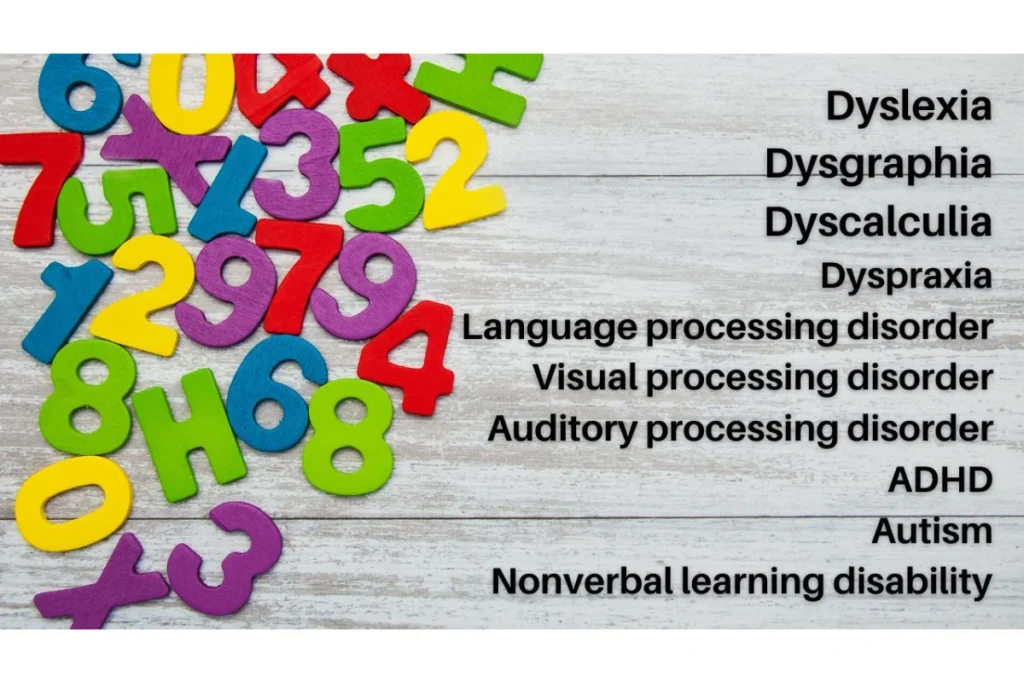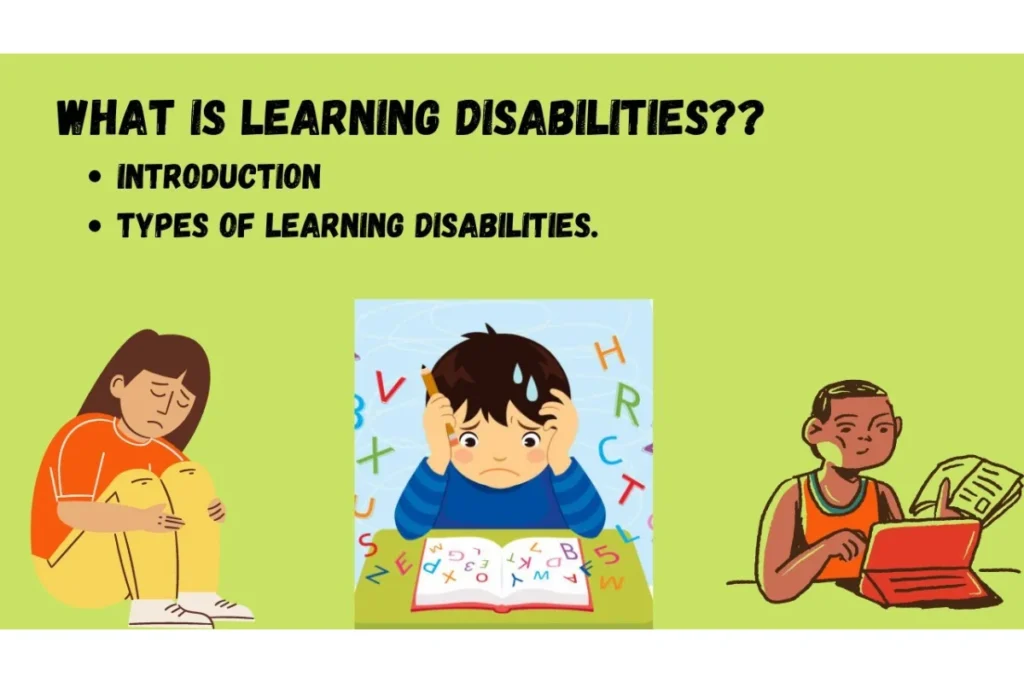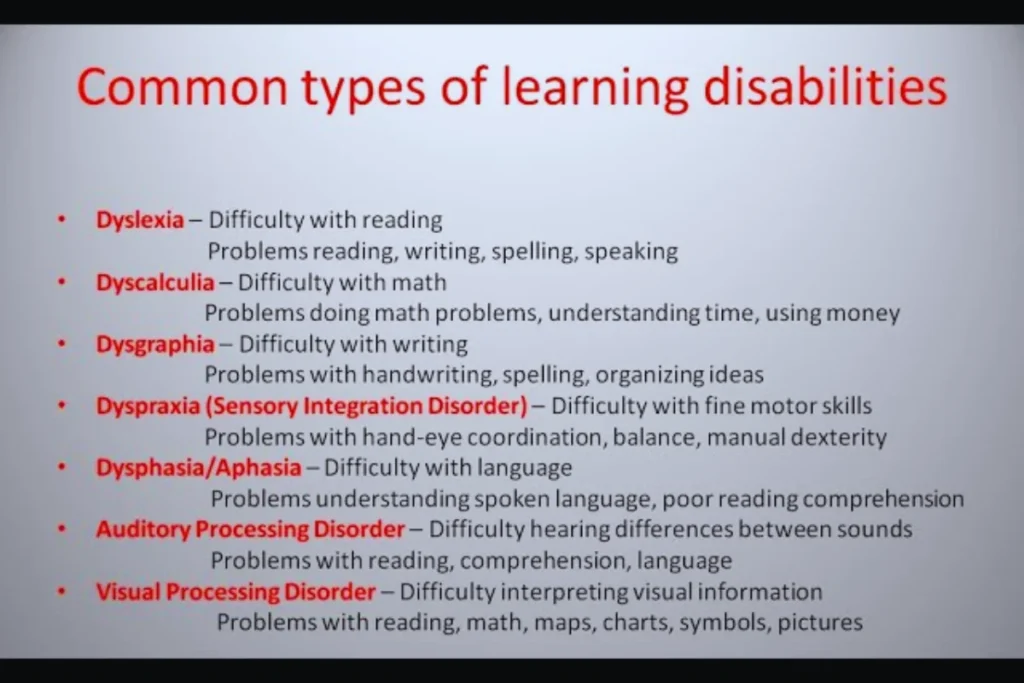Learning disabilities affect 15% of people worldwide, impacting how they process and use information in daily life, academics, and social situations. These neurological differences require understanding and support.
This evidence-based guide covers various types of learning disabilities and provides evidence-based strategies for educators, healthcare providers, and families.
Table of Contents
Examples of Learning Disabilities and Their Impact
Learning disabilities are neurodevelopmental conditions that affect cognitive processes related to learning. Recent progress in neuroscience and educational psychology has helped us learn more about the different types of learning disabilities:
- Dyslexia
- Dyscalculia
- Dysgraphia
- Auditory Processing Disorder
- Visual Processing Disorder
- Language Processing Disorder
- Non-Verbal Learning Disabilities
This progress has made it easier to identify these challenges and find better ways to support them. For more information on the causes of learning disabilities, visit our detailed guide.
By understanding this list of learning disabilities, families, teachers, and caregivers can offer the right support, helping individuals succeed in school and daily life. Learn more about the 7 main categories of learning disabilities in our guide.
What Are the 7 Main Types of Learning Disabilities?
1. Dyslexia: Reading and Language Processing
Dyslexia, the most prevalent learning disability, affects approximately 10-15% of the population. This condition impacts reading fluency, comprehension, and written expression. Key characteristics include:
- Difficulty with phonological processing (processing sounds in words)
- Challenges in word recognition and decoding
- Problems with reading comprehension
- Struggles with spelling and written expression
Modern diagnostic tools and neuroimaging have revealed that dyslexia involves differences in how the brain processes language-related information, particularly in the left hemisphere’s reading networks.

2. Dyscalculia: Mathematical Processing Challenges
Dyscalculia affects mathematical reasoning and computation abilities. Individuals with this condition may experience:
- Difficulty understanding number concepts
- Problems with mathematical operations
- Challenges in spatial reasoning
- Trouble with time concepts and money management
Research indicates that approximately 6% of school-age children experience some form of dyscalculia, highlighting the need for specialised mathematical instruction approaches.
3. Dysgraphia: Written Expression Difficulties
Dysgraphia impacts handwriting, spelling, and written expression. This condition manifests through:
- Poor handwriting and spatial planning
- Inconsistent spacing between letters and words
- Difficulty with sentence structure and organization
- Challenges in translating thoughts into written text
Assistive tools like speech-to-text software, smart pens, and graphic organizers simplify writing for individuals with dysgraphia, offering effective alternatives.
4. Auditory Processing Disorder (APD)
APD affects how the brain processes auditory information, impacting language comprehension and communication. Common symptoms include:
- Difficulty following verbal instructions
- Problems distinguishing similar sounds
- Challenges in noisy environments
- Delayed language processing
Advanced hearing assessment technologies have improved early identification and intervention for APD, leading to better outcomes.
5. Visual Processing Disorder
This condition affects the brain’s ability to process visual information effectively. Characteristics include:
- Struggles to tell apart similar shapes or letters
- Has trouble understanding how things fit together
- Finds it hard to remember things they see
- Has difficulty making sense of what they read
Modern educational technology includes multisensory approaches to support individuals with visual processing disorders.
6. Language Processing Disorder
Language processing disorders affect both receptive and expressive language abilities. Key features include:
- Finds it hard to understand spoken words
- Struggles to find the right words to say
- Has trouble explaining their thoughts clearly
- Struggles to understand what they read
Integrated speech and language therapy approaches have shown significant success in supporting individuals with these disorders.
7. Non-Verbal Learning Disabilities
These disabilities affect social skills, spatial awareness, and motor coordination. Common manifestations include:
- Finds it hard to read body language or gestures
- Struggles to know where things are around them
- Has trouble with small, careful movements
- Finds it hard to understand big, tricky or abstract ideas
Summary of Different Forms of Learning Disabilities

Each type of learning disability presents unique challenges and requires specialized support approaches. Here’s a complete overview:
| Type | Primary Challenges | Common Symptoms | Support Strategies |
| Dyslexia | Reading and language processing | Difficulty with phonological awareness, slow reading speed | Structured literacy programs, audiobooks |
| Dysgraphia | Written expression | Poor handwriting, struggles with composition | Assistive technology, occupational therapy |
| Dyscalculia | Mathematical concepts | Number recognition issues, difficulty with calculations | Multi-sensory math instruction, specialized tools |
| Auditory Processing Disorder | Sound interpretation | Trouble following verbal instructions | FM systems, written instructions |
| Visual Processing Disorder | Visual information processing | Difficulty with reading maps, charts | Visual aids, organizational tools |
| Nonverbal Learning Disabilities | Social cues, spatial awareness | Challenges with body language interpretation | Social skills training, explicit instruction |
| ADHD* | Attention and focus | Impulsivity, difficulty maintaining attention | Behavioural strategies, structured environments |
*Note: While ADHD’s classification as a learning disability is debated, it significantly impacts learning processes and often co-occurs with other learning disabilities.
Signs and Symptoms of Learning Disabilities
Early recognition of learning disabilities is crucial for timely intervention and support. Common indicators include:
In Children:
- Trouble learning to speak or delayed language skills
- Difficulty understanding or following instructions
- Struggles with reading, writing, or simple math
- Forgetting things quickly or poor memory
- Clumsiness or difficulty with coordination
In Adults:
- Trouble staying organised or managing tasks
- Problems managing time effectively
- Struggles with reading and writing tasks
- Difficulty solving math problems or handling numbers
- Challenges in social situations or forming relationships
Recognising the early signs can lead to timely support. Learn more about the signs of learning disabilities in adults to identify potential challenges and seek help. For a deeper understanding, check out the difference between autism and learning disabilities.
How Are Learning Disabilities Diagnosed?
The diagnostic process involves thorough evaluation across multiple domains:
| Assessment Type | Purpose | Professional Involved |
| Cognitive Assessment | Evaluate information processing | Educational Psychologist |
| Academic Achievement Tests | Measure skill levels | Special Education Teacher |
| Speech-Language Evaluation | Assess communication skills | Speech-Language Pathologist |
| Medical Examination | Rule out physical causes | Healthcare Provider |
Steps in the Diagnostic Journey
- Initial Screening: Specialists observe behaviours and learning patterns to identify potential concerns.
- Detailed Evaluation: Experts conduct in-depth tests and assessments to understand specific challenges.
- Creating Support Plans: Custom strategies are developed to address individual needs.
- Ongoing Monitoring: Progress is reviewed regularly, and plans are adjusted as needed for continued growth.
Support and Resources for Learning Disabilities
Support for learning disabilities includes education, therapy, and technology to help individuals live independently.
Digital Support Solutions
Today’s technology has transformed support for learning disabilities. Tools are now more accessible and adaptable to individual needs.
| Technology Category | Key Tools | Primary Benefits |
| Literacy Support | 1. Learning Ally 2. Grammarly 3. Microsoft Immersive Reader | 1. 50% improvement in reading comprehension 2. Enhanced writing confidence 3. Better information processing |
| Mathematical Learning | 1. Number 2. Shark 3. ModMath 4. PhotoMath | 1. Improved calculation accuracy 2. Visual learning support 3. Step-by-step guidance |
| Organization & Planning | 1. Microsoft OneNote 2. Trello 3. Google Calendar | 1. Better task management 2. Improved time organization 3. Enhanced study skills |
Learning Disability Care Home
Learning Disability Care Homes in London provide a supportive environment designed to meet individual needs. These care homes provide:
- Personalised Care Plans: Designed around each individual’s strengths and challenges.
- Daily Living Support: Assistance with routines like meal preparation and personal care.
- Skill Development: Focused activities to increase independence.
- Community Engagement: Opportunities for social interaction and inclusion.
Future Directions in Learning Disability Support
The future of learning disability support is being shaped by groundbreaking research and technological innovation.
| Innovation Area | Current Applications | Future Impact |
| Artificial Intelligence | 1. Personalized learning algorithms 2. Smart tutoring systems | 1. Real-time learning adaptation 2. Early intervention opportunities |
| Neuroplasticity Research | 1. Targeted cognitive training 2. Brain-computer interfaces | 1. Enhanced learning pathways 2. Customized intervention strategies |
| Virtual Reality | 1. Social skills practice 2. Immersive learning environments | 1. Safe practice spaces 2. Enhanced engagement |
Beyond these technological advances, the field is moving toward more integrated support systems that consider the whole person. Research shows that successful outcomes depend on:
- Early identification and intervention
- Inclusive support networks
- Regular progress monitoring
- Family involvement
- Community integration
Looking ahead, the focus will be on developing more accessible and affordable support tools while maintaining the crucial balance between technological innovation and human-centred support.
This evolution in learning disability support promises to create more inclusive and effective educational environments for all learners. Learn more about these activities for learning disabilities for practical support.
Additional Resources for Learning Disabilities
| Resource Type | Name | Benefits |
| Organizations | British Dyslexia Association | Comprehensive support and advocacy |
| Digital Tools | Learning Ally | Audiobook access and reading support |
| Support Networks | ADHD Foundation | Specialized guidance and community |
| Educational Resources | National Center for Learning Disabilities | Research-based strategies and |
Conclusion
Understanding different types of learning disabilities requires a nuanced approach. We need to consider both the neurological foundations and the practical implications for daily life. As our knowledge expands and technology advances, the opportunities for support and intervention continue to grow. The key to success lies in
- early identification,
- appropriate intervention, and
- consistent support through evidence-based strategies.
Using modern technology alongside traditional support provides new ways to help people with learning disabilities. Understanding learning disabilities requires clarity.
Learn what is a learning disability and how early intervention can help. Visit Metro Care UK for expert support.
FAQs About Learning Disabilities
What are the 5 most common learning disabilities?
The most frequently diagnosed learning disabilities include:
1. Dyslexia
2. ADHD (when considered a learning disability)
3. Dyscalculia
4. Dysgraphia
5. Auditory Processing Disorder
Is ADHD considered a learning disability?
While ADHD is technically classified as a neurodevelopmental disorder, it significantly impacts learning processes and often co-occurs with specific learning disabilities. The distinction lies in its primary effects on attention and behaviour rather than specific learning skills.
What can be mistaken for a learning disability?
Several factors can present similarly to learning disabilities:
1. Anxiety and stress
2. Cultural and language differences
3. Limited educational opportunities
4. Vision or hearing problems
5. Emotional trauma
Can you tell if someone has a learning disability?
Learning disabilities are not always visible and require professional assessment for diagnosis. However, persistent struggles with specific tasks despite adequate instruction and support may indicate the need for evaluation.

